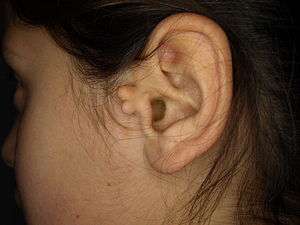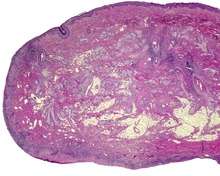Accessory auricle
| Accessory auricle | |
|---|---|
 | |
| Classification and external resources | |
| Specialty | medical genetics |
| ICD-10 | Q17.0 |
| ICD-9-CM | 744.1 |
| OMIM | 610420 |
An accessory auricle is considered a developmental anomaly resulting from the persistence of a structure which variably recapitulates the normal external ear.
Classification
There may be several components or degrees of development, ranging from an ear tag, preauricular appendage, preauricular tag, accessory tragus, to supernumerary ears or polyotia .[1] It is a relatively common congenital anomaly of the first branchial arch or second branchial arches. Other anomalies may be present concurrently, including cleft palate, cleft lip, or mandibular hypoplasia. There is a known association with Goldenhar syndrome (oculo-auriculo-vertebral syndrome)[2] and with Wildervanck syndrome.[3][4][5] There may also be an association with congenital cartilaginous rest of the neck.
Signs and symptoms
The general presentation is of a skin-covered nodule, papule or nodule of the skin surface, usually immediately anterior to the auricle. However, it may be anywhere within the periauricular tissues. Bilateral presentation can be seen.[6][7][8][9][10]
Pathology findings

The lesions presents as a nodule or papule, either sessile or pedunculated. They may be soft or have a cartilaginous structure. By histologic examination, it is a recapitulation of normal external auricle. There will be skin, cartilaginous structures, and cartilage (although the later is not seen in all variants of this disorder).[8][9] Some investigators believe that the tragus is the only hillock which is derived from the first branchial arch. This is clearly suggestive that true cases of Accessory Auricle represent a true duplication of the hillocks that were part of the second branchial arch.[11] The second ear appears as a mirror image folded forward and lying on the posterior cheek.
Differential diagnosis
These structures are distinctly different from squamous papilloma and benign teratoma.
Management
Simple surgical excision is curative.[12] The recommended treatment is that the skin is peeled off the extra-auricular tissue and protruding cartilage remnants are trimmed.[13] Normal appearance is achieved in majority of cases. The reconstruction successful in true cases of Accessory Auricle as it also is in individuals with auricular appendages.[14][15]
Epidemiology
These lesions usually present in neonates, although they may not come to clinical attention until adulthood (for cosmetic reasons). There is no gender predilection. They are present in approximately 3-6 per 1000 live births.[16]
See also
References
- ↑ Lam, J.; Dohil, M. (2007). "Multiple Accessory Tragi and Hemifacial Microsomia". Pediatric Dermatology. 24 (6): 657–658. doi:10.1111/j.1525-1470.2007.00560.x. PMID 18035991.
- ↑ Konaş, E.; Canter, H. I.; Mavili, M. E. (2006). "Goldenhar complex with atypical associated anomalies: Is the spectrum still widening?". The Journal of craniofacial surgery. 17 (4): 669–672. doi:10.1097/00001665-200607000-00011. PMID 16877912.
- ↑ Tadini, G.; Cambiaghi, S.; Scarabelli, G.; Brusasco, A.; Vigo, P. (1993). "Familial occurrence of isolated accessory tragi". Pediatric dermatology. 10 (1): 26–28. doi:10.1111/j.1525-1470.1993.tb00006.x. PMID 8493161.
- ↑ Gao, J. Z.; Chen, Y. M.; Gao, Y. P. (1990). "A survey of accessory auricle anomaly. Pedigree analysis of seven cases". Archives of otolaryngology--head & neck surgery. 116 (10): 1194–1196. PMID 2206506.
- ↑ Resnick, K. I.; Soltani, K.; Bernstein, J. E.; Fathizadeh, A. (1981). "Accessory tragi and associated syndromes involving the first branchial arch". The Journal of dermatologic surgery and oncology. 7 (1): 39–41. doi:10.1111/j.1524-4725.1981.tb00591.x. PMID 7204730.
- ↑ Cosman, B. C. (1993). "Bilateral accessory tragus". Cutis; cutaneous medicine for the practitioner. 51 (3): 199–200. PMID 8444054.
- ↑ "Preauricular sinus and accessory auricle. (Photoclinic)." Consultant Feb. 2002: 256+. Health Reference Center Academic. Web. 2 Nov. 2011.
- 1 2 Jansen, T.; Romiti, R.; Altmeyer, P. (2000). "Accessory tragus: Report of two cases and review of the literature". Pediatric dermatology. 17 (5): 391–394. doi:10.1046/j.1525-1470.2000.017005391.x. PMID 11085670.
- 1 2 Brownstein, M. H.; Wanger, N.; Helwig, E. B. (1971). "Accessory tragi". Archives of dermatology. 104 (6): 625–631. PMID 5131708.
- ↑ Hodges FR; Sahouria JJ; Wood AJ (2006). "Accessory tragus: A report of 2 cases". J Dent Child (Chic). 73 (1): 42–4. PMID 16734313.
- ↑ Stevenson, Roger E.; Hall, Judith G. Human Malformations and Related Anomalies (2nd ed.). Oxford University Press, USA, 2005. pp. 339, 340. ISBN 019974808X.
- ↑ Pan, B.; Qie, S.; Zhao, Y.; Tang, X.; Lin, L.; Yang, Q.; Zhuang, H.; Jiang, H. (2010). "Surgical management of polyotia". Journal of Plastic, Reconstructive & Aesthetic Surgery. 63 (8): 1283–1288. doi:10.1016/j.bjps.2009.06.037. PMID 19617017.
- ↑ Scott-Brown's Otorhinolaryngology (7th ed.). Hodder Arnold. p. 969. ISBN 978 0 340 808 931.
- ↑ Ku, PK; Tong, MC; Yue, V (1998). "Polyotia- a rare external ear anomaly". Int J Pediatr Otorhinolaryngol (46:117).
- ↑ Bendor-Samuel, RL; Tung, TC; Chen, YR (1995). "Polyotia". Ann Plast Surg (34:650).
- ↑ Rapini, Ronald P.; Bolognia, Jean L.; Jorizzo, Joseph L. (2007). Dermatology: 2-Volume Set. St. Louis: Mosby. p. 894. ISBN 1-4160-2999-0.
Further reading
Lester D. R. Thompson; Bruce M Wenig (2011). Diagnostic Pathology: Head and Neck: Published by Amirsys. Hagerstown, MD: Lippincott Williams & Wilkins. pp. 7:2–3. ISBN 1-931884-61-7.